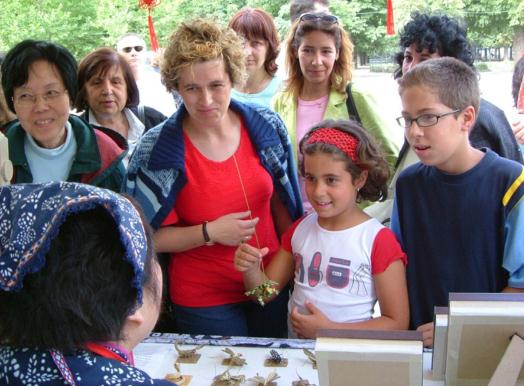

n this 2004 file photo, French people are amazed at handicrafts made of palm leaves by Shanghai folk artists during the "Shanghai Week" held at the Tuileries Garden in Paris. — Su Yizhong/Shanghai Daily
Amid increasing recognition that parts of China's rich cultural history are quietly drowning in the nation's frenetic development, more steps are being taken to protect them.
In Shanghai, the city's intangible cultural heritage is about to be incorporated into the curriculum of local universities, officials said on Sunday at a signing ceremony with the MBA center of Shanghai University.
"It is just the beginning of our efforts to bring intangible cultural heritage to campus," says Yang Qinghong, an official with the Shanghai Municipal Administration of Culture, Radio, Film and TV. "We are also planning to set up new undergraduate and postgraduate majors and compile the relevant contents into textbooks."
Culture and history experts and practitioners will regularly share with students their expertise and experience in preserving the endangered arts, traditions, practices and skills.
Today, China has 30 items listed on the UNESCO's Intangible Cultural Heritage list, including Kunqu Opera, calligraphy, paper cutting, acupuncture, shadow puppetry and Chinese abacus. Many of the items are at the edge of extinction these days, and largely a cultural relic.
A total of 49 items of Shanghai have been included on China's state-level list of intangible cultural heritage and the number of the city-level items has reached 179, covering music, dance, traditional opera, literature, painting, medicine, textiles, folk arts and handicraft.
Protection of intangible cultural heritage in China started in 2005. According to Yang, though it was decades later than the work begun in Japan and South Korea, considerable progress has been made over the passing years.
In 2011, China passed the country's first law on intangible cultural heritage protection to preserve and develop shrinking cultures. The law encouraged enterprises, groups and individuals to get more engaged in the protection.
"We have made a name list for the inheritors of the endangered arts, launched special funds and recorded the items through digital visual-audio files to ensure their inheritance," Yang says. "It is a long-term work that requires efforts from the whole society."
Liu Haibo, deputy director of the Shanghai Vancouver Film School, a collaboration of Shanghai University and the Vancouver Film School, says that modern technical means will be devised to preserve them.
"China boasts a rich and diverse intangible cultural heritage," says Liu. "The younger generation of the country should never lose their affection and connection with humanity and culture. Shooting documentaries and films is a useful method to provide an insight into the charm and stories of the age-old art forms."
Professor Cai Fengming, an expert from the Shanghai Academy of Social Sciences, says that many of the city's intangible cultural heritage items feature a distinctive East-meets-West flavor after Shanghai was opened up as a commercial port in 1843.
He mentions the shikumen (stone-gate) lifestyle and Tushanwan, which is known as China's "cradle of Western painting." The shikumen buildings boast a mix of Chinese and foreign styles of architecture and used to be a main residence of people in Shanghai.
Tibet‘s intangible heritage well-protected: official
2014-08-14S China Karst extension listed as World Heritage Site
2014-06-24Copyright ©1999-2018
Chinanews.com. All rights reserved.
Reproduction in whole or in part without permission is prohibited.